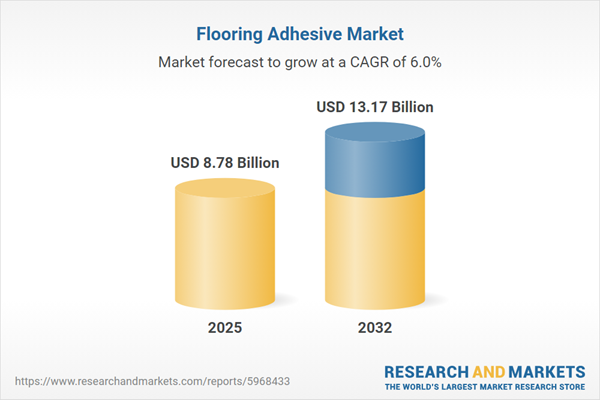Speak directly to the analyst to clarify any post sales queries you may have.
The flooring adhesive market is experiencing a period of transformative growth, driven by evolving material science, regulatory pressures, and heightened demands for sustainability and performance across global construction and renovation sectors. Industry leaders are leveraging advancements in chemistry and digital workflows to align product portfolios with the expectations of contemporary commercial, industrial, and residential applications.
Market Snapshot: Flooring Adhesive Market Size and Growth
The Flooring Adhesive Market grew from USD 8.27 billion in 2024 to USD 8.78 billion in 2025. It is expected to continue growing at a CAGR of 5.98%, reaching USD 13.17 billion by 2032. This sustained expansion is closely linked to technological advances in polymer chemistry, increased regulatory focus on environmental compliance, and shifts in global supply chain hubs.
Scope & Segmentation
- Technology: Reactive (Epoxy, Urethane), Solvent Based, Water Based
- Type: Paste, Powder, Pre Mixed (Cartridge, Drum)
- End Use: Commercial, Industrial, Residential (Multi Family, Single Family)
- Application: Carpet, Tiles, Vinyl Flooring, Wooden Flooring (Engineered Wood, Solid Wood)
- Distribution Channel: Direct Sales, Distributors, Online (Company Website, E Commerce Portal)
- Geographic Regions:
- Americas (North America: United States, Canada, Mexico; Latin America: Brazil, Argentina, Chile, Colombia, Peru)
- Europe, Middle East & Africa (Europe: United Kingdom, Germany, France, Russia, Italy, Spain, Netherlands, Sweden, Poland, Switzerland; Middle East: United Arab Emirates, Saudi Arabia, Qatar, Turkey, Israel; Africa: South Africa, Nigeria, Egypt, Kenya)
- Asia-Pacific (China, India, Japan, Australia, South Korea, Indonesia, Thailand, Malaysia, Singapore, Taiwan)
- Leading Companies: Sika AG, Henkel AG & Co. KGaA, MAPEI S.p.A., Bostik SA, RPM International Inc., H.B. Fuller Company, Laticrete International, Inc., Ardex GmbH, ParexGroup S.A.S., Fosroc International Ltd.
Key Takeaways for Flooring Adhesive Market Strategy
- Increasing demand for high-performance, low-emission adhesives is reshaping specification requirements across all construction segments.
- Innovations in nanotechnology and bio-based chemistry are strengthening adhesive durability, meeting both performance and sustainability targets.
- Digital fabrication and automated dispensing systems are supporting installation accuracy while reducing material waste and human error.
- Collaborative partnerships between adhesive manufacturers and equipment providers are enabling vertically integrated, end-to-end solutions.
- Agility in raw material sourcing and alternative chemistries is essential as evolving regulations and tariffs alter supply and production dynamics.
- Regional manufacturers are tailoring formulations and distribution strategies to address local climate, regulatory pressures, and construction practices.
Tariff Impact and Global Supply Chain Realignment
The implementation of United States tariffs on key raw materials in 2025 has led manufacturers to reconsider supply chains, boost domestic production for critical inputs, and prioritize alternative chemistries that minimize exposure to fluctuating duties. This has resulted in increased use of locally sourced reagents, new production hubs, and longer-term supplier contracts to stabilize costs and reinforce supply reliability.
Methodology & Data Sources
This report combines extensive primary research, including executive interviews and procurement insights, with rigorous analysis of regulatory documents, patent trends, and benchmarking against adjacent markets. Quantitative validation is ensured through advanced statistical modeling of industry shipment and supply chain data.
Why This Report Matters
- Enables executives to identify high-growth technology and application corridors within the competitive flooring adhesive market.
- Details strategic responses to regulatory changes and supply chain volatility, supporting risk mitigation and long-term planning.
- Empowers decision-makers with actionable, segment-specific intelligence for product development and geographic expansion.
Conclusion
The flooring adhesive industry is being shaped by innovation, sustainability, and resilience in supply strategy. Senior decision-makers equipped with these insights are well positioned to capitalize on growth avenues while navigating global complexities.
Additional Product Information:
- Purchase of this report includes 1 year online access with quarterly updates.
- This report can be updated on request. Please contact our Customer Experience team using the Ask a Question widget on our website.
Table of Contents
3. Executive Summary
4. Market Overview
7. Cumulative Impact of Artificial Intelligence 2025
Companies Mentioned
The companies profiled in this Flooring Adhesive market report include:- Sika AG
- Henkel AG & Co. KGaA
- MAPEI S.p.A.
- Bostik SA
- RPM International Inc.
- H.B. Fuller Company
- Laticrete International, Inc.
- Ardex GmbH
- ParexGroup S.A.S.
- Fosroc International Ltd.
Table Information
| Report Attribute | Details |
|---|---|
| No. of Pages | 198 |
| Published | October 2025 |
| Forecast Period | 2025 - 2032 |
| Estimated Market Value ( USD | $ 8.78 Billion |
| Forecasted Market Value ( USD | $ 13.17 Billion |
| Compound Annual Growth Rate | 5.9% |
| Regions Covered | Global |
| No. of Companies Mentioned | 11 |









